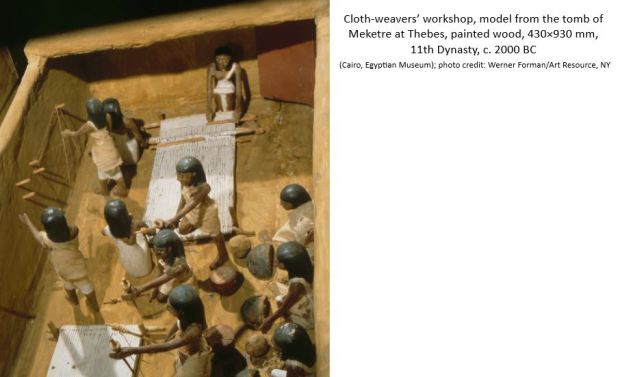I have a quiz Thursday for my History of Textiles class, you’re going to help me study. The notes I’m using are based off of my reading in 5000 Years of Textiles, edited by Jennifer Harris.
Ancient World/Ancient Egyptian Textiles
- Flax was the most commonly used plant fiber. Ancient findings of domesticated flax seed, spindle whorls date as far back as 5000-6000 BC in Syria, Iran and Egypt.
- Georgia caves had 30,000 year old flax, twisted and dyed, evidence of some sort of sewing/basket weaving.
- Domestication of sheep, goat, dogs dates as far back as 9000 BC in Iraq, Iran, Pakistan and Turkey.
Dyes
- Ancient Egyptians and Jews preferred white linen for religious reasons; represented purity
- Egyptian wall paintings depicted foreigners wearing colorful pattered robes and clothing
- Purple = royalty
Early Trade
- Trade was established as early as the Neolithic Period
- Wool and cloth were the most popular to trade
- Book of Ezekiel in the Bible documents wool and Egyptian linen being traded in Damascus
Ancient Egypt
- Dry, sterile sands have preserved tools, textiles and pictorial evidence
- Linen was the most popular fiber. Flax cultivation and fiber production was a man’s work. Spinning and weaving was considered women’s work.
- Flat, smooth wooden disc whorl was used with spindle
- Egyptian cloth was of very high quality because it was done with great detail and preparation
- During The Middle Kingdom (2133-1786 BC) two-beam horizontal/ground loom was used in Egypt till the end of the Middle Kingdom
- During the Early New Kingdom (1522 BC) domed spindle whorls and vertical two-beam looms were used. Professional weavers were male. Linen cloth was finished by washing it and then sun dried to bleach it. Adding saffron gave the linen a yellow tint and also acted as an insecticide.
- The Hellenistic Kingdom meant that Greeks acquired a larger influence to the ancient Egyptians. “Hellenistic” = “Greek-ish” Greeks loved richly colored fabrics. Pattern weaving became popular, tapestry weaving might have originated during this time.
- ‘Coptic’ is a nineteenth-century blanket term for post-Pharaonic textiles. After the Pharaohs, Egypt became layered with different cultures. Christianity made a huge influence during this time as well.

